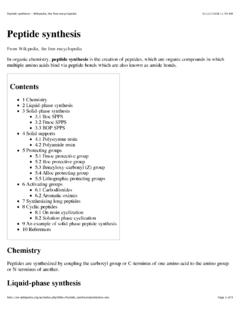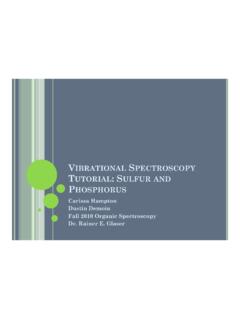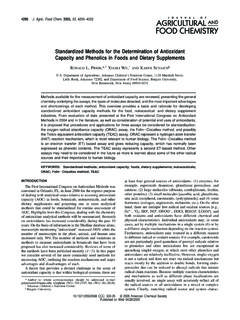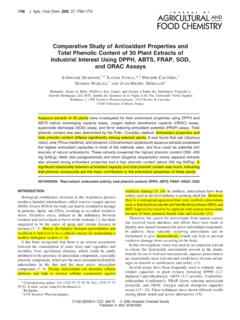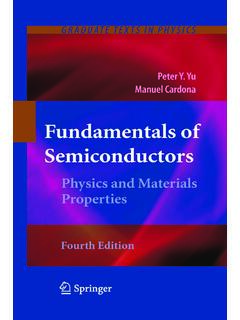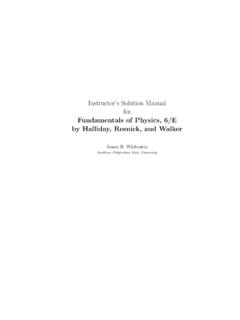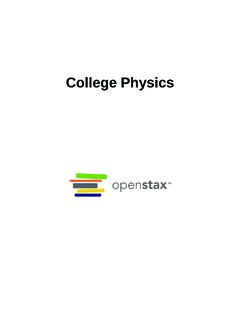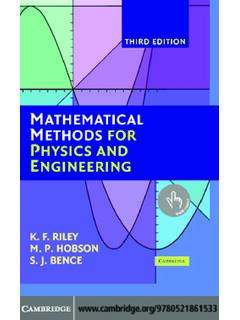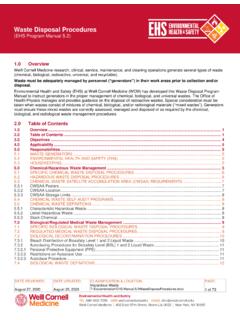Transcription of Students Solutions Manual PARTIAL DIFFERENTIAL …
1 Students Solutions ManualPARTIAL DIFFERENTIALEQUATIONS with FOURIER SERIES andBOUNDARY VALUE PROBLEMSS econd EditionNAKHL E of MissouriContentsPrefacevErratavi1A Preview of Applications and Is a PARTIAL DIFFERENTIAL Equation? and Interpreting a PARTIAL DIFFERENTIAL Equation 22 Fourier Functions Series Series of Functions with Arbitrary Periods Expansions: The Cosine and Sine Series Square Approximation and Parseval s Identity Form of Fourier Series Oscillations 21 Supplement on Convergence and Fourier Series Test and Convergence of Fourier Series 283 PARTIAL DIFFERENTIAL equations in Rectangular DIFFERENTIAL equations in physics and Engineering of the One Dimensional Wave Equation:The Method of Separation of Variables Alembert s Method One Dimensional Heat Equation Conduction in Bars: Varying the Boundary Conditions Two Dimensional Wave and Heat equations s Equation in Rectangular Coordinates s Equation.
2 The Method of Eigenfunction Expansions and Robin Conditions 52 Contentsiii4 PARTIAL DIFFERENTIAL equations inPolar and Cylindrical Laplacian in Various Coordinate Systems of a Circular Membrane: Symmetric Case of a Circular Membrane: General Case s Equation in Circular Regions s Equation in a Cylinder Helmholtz and Poisson equations 65 Supplement on Bessel s Equation and Bessel Functions Series Expansions Formulas and Asymptotics for Bessel Functions 795 PARTIAL DIFFERENTIAL equations in Spherical of Problems and Methods Problems with Symmetry Harmonics and the General Dirichlet Problem Helmholtz Equation with Applications to the Poisson, Heat,and Wave equations 86 Supplement on Legendre s DIFFERENTIAL Equation Polynomials and Legendre Series Expansions 916 Sturm Liouville Theory with Engineering Functions Liouville Theory Hanging Chain Order Sturm Liouville Theory Biharmonic Operator of Circular Plates 104ivContents7 The Fourier Transform and Its Fourier Integral Representation Fourier Transform Fourier Transform Method Heat Equation and Gauss s Kernel Dirichlet Problem and the Poisson Integral Formula Fourier Cosine and Sine Transforms Involving Semi-Infinite Intervals Functions Nonhomogeneous Heat Equation s Principle 1348 The Laplace and Hankel Transforms with Laplace Transform Properties of the Laplace transform Laplace Transform
3 Method Hankel Transform with Applications 14812 Green s Functions and Conformal s Theorem and Identities Functions and Green s Identities s Functions s Functions for the Disk and the Upper Half-Plane Functions Dirichlet Problems with Conformal Mappings s Functions and Conformal Mappings 165 AOrdinary DIFFERENTIAL equations :Review of Concepts and Ordinary DIFFERENTIAL equations Ordinary DIFFERENTIAL Equationswith Constant Coefficients Ordinary DIFFERENTIAL Equationswith Nonconstant Coefficients Power Series Method, Part I Power Series Method, Part II Method of Frobenius A197 PrefaceThis Manual contains Solutions with notes and comments to problems from thetextbookPartial DIFFERENTIAL Equationswith Fourier Series and Boundary Value ProblemsSecond EditionMost Solutions are supplied with complete details and can be used to supplementexamples from the text.
4 Additional Solutions will be posted on my nakhleas I complete them and will be included in future versions of this would like to thank users of the first edition of my book for their valuable com-ments. Any comments, corrections, or suggestions would be greatly e-mail address e H. AsmarDepartment of MathematicsUniversity of MissouriColumbia, Missouri 65211 ErrataThe following mistakes appeared in the first printing of the second edition (up-dates24 March 2005).Corrections in the text and figuresp. 224, Exercise #13 is better done after Section 268, Exercise #8(b),nshould be , Exercise#12, usey2=I0(x) noty2=J1(x). , line 7, the integrals should be from to .p. 425 Figures 5 and 6: Relabel the ticks on thex-axis as , /2, /2, , insteadof 2 , , ,2 .p. 467, line ( 3): Change reference (22) to (20).
5 P. 477, line 10: (xt) (x, t).p. 477, line 19: Change interval to triangle p. 487, line 1: Change is the equal to is equal p. 655, line 13: Change ln|ln(x2+y2)|to ln(x2+y2).p. A38, the last two lines of Example 10 should be:=(a1 2a0)+(2a2 a1)x+ m= m=0[(m+1)am+1+am(m2 2)] page on inside back cover: Improper integrals, lines 3, the first integralshould be from 0 to and not from to .Corrections to Answers of Odd ExercisesSection , # 7: Changeito , # 13:f(x) = 3 for 1<x<3 not 1<x< , # 35: 2 (e iw 1)w 3j=1jsin(jw). # 37:i 2 1w3, # 51:3 2 [ 1 0].# 57: The given answer is the derivative of the real answer, which should be1 2 ((x+2)(U 2 U0)+( x+2)(U0 U1)+(U1 U3)+( x+4)(U3 U4))# 59: The given answer is the derivative of the real answer, which should be121 2 ((x+3)(U 3 U 2)+(2x+5)(U 2 U 1)+(x+4)(U 1 U0)+( x+4)(U0 U1)+( 2x+5)(U1 U2)+( x+3)(U2 U3))Section , # 9:12[tsin(x+t)+12cos(x+t) 12cos(x t)].
6 Appendix , # 43:y=c1cos 3x+c2sin 3x 118xcos 3x+ 6n=1,n6=3sinnxn(9 n2).# 49:yp=.. yp=x(..# 67:y= 18ex+132e3x+(18x+332)e , # 9:y=c1x+c2[x2ln(1+x1 x) 1].# 25 ln(cosx) ln|cosx|.#27y=c1(1 +x)+c2ex x32 , # 13 1+4 n=0( 1)nxnAppendix , # 15y=1 6x2+3x4+45x6+ Any suggestion or correction would be greatly appreciated. Please send themto my e-mail e H. AsmarDepartment of MathematicsUniversity of MissouriColumbia, Missouri 65211 Section What Is a PARTIAL DIFFERENTIAL Equation?1 Solutions to Exercises Solutions of (1), then u1 t+ u1 x= 0 and u2 t+ u2 x= taking derivatives is a linear operation, we have t(c1u1+c2u2)+ x(c1u1+c2u2)=c1 u1 t+c2 u2 t+c1 u1 x+c2 u2 x=c1=0 ( u1 t+ u1 x)+c2=0 ( u2 t++ u2 x)=0,showing thatc1u1+c2u2is a solution of (1). =ax+bt, =cx+dt, then u x= u x+ u x=a u +c u u t= u t+ u t=b u +d u.)
7 Recalling the equation, we obtain u t u x=0 (b a) u +(d c) u = ,b=2,c=1,d= 1. Then u =0 u=f( ) u(x, t)=f(x+t),wherefis an arbitrary differentiable function (of one variable).9.(a) The general solution in Exercise 5 isu(x, t)=f(x+t). Whent= 0, we getu(x,0) =f(x)=1/(x2+ 1). Thusu(x, t)=f(x+t)=1(x+t)2+1.(c) Astincreases, the wavef(x)=11+x2moves to the Exercise 9(b). find the characteristic curves, solvedydx= cosx+Cory+ cosx=C. Thus the solution of the PARTIAL DIFFERENTIAL equation isu(x, y)=f(y+ cosx). To verify the solution, we use the chain rule and getux= sinxf (y+ cosx) anduy=f (y+ cosx). Thusux+ sinxuy= 0, 1 A Preview of Applications and TechniquesExercises have t( u t)= t( v x)and x( v t)= x( u x).So 2u t2= 2v t xand 2v x t= 2u that 2v t x= 2v x t, it follows that 2u t2= 2u x2, which is the one dimensionalwave equation withc= 1.
8 A similar argument shows thatvis a solution of the onedimensional wave (a) We haveu(x, t)=F(x+ct)+G(x ct). To determineFandG, we usethe initial data:u(x,0) =11+x2 F(x)+G(x)=11+x2; (1) u t(x,0) = 0 cF (x) cG (x)=0 F (x)=G (x) F(x)=G(x)+C,(2)whereCis an arbitrary constant. Plugging this into (1), we find2G(x)+C=11+x2 G(x)=12[11+x2 C];and from (2)F(x)=12[11+x2+C].Henceu(x, t)=F(x+ct)+G(x ct)=12[11+(x+ct)2+11+(x ct)2]. the hint suggests, we consider two separate problems: The problem inExercise 5 and the one in Exercise 7. Letu1(x, t) denote the solution in Exercise 5andu2(x, t) the solution in Exercise 7. It is straightforward to verify thatu=u1+u2is the desired solution. Indeed, because of the linearity of derivatives, wehaveutt=(u1)tt+(u2)tt=c2(u1)xx+c2(u2)x x, becauseu1andu2are solutionsof the wave equation.
9 Butc2(u1)xx+c2(u2)xx=c2(u1+u2)xx=uxxand soutt=c2uxx, showing thatuis a solution of the wave equation. Nowu(x,0) =u1(x,0)+u2(x,0) = 1/(1+x2)+0, becauseu1(x,0) = 1/(1+x2) andu2(x,0) = ,ut(x,0) = 2xe x2; thusuis the desired solution. The explicit formulaforuisu(x, t)=12[11+(x+ct)2+11+(x ct)2]+12c[e (x+ct)2 e (x ct)2]. function being graphed isu(x, t) = sin xcos t 12sin2 xcos 2 t+13sin 3 xcos 3 frames 2, 4, 6, and 8,t=m4, wherem=1,3,5, and 7. Plugging this intou(x, t), we findu(x, t) = sin xcosm 4 12sin 2 xcosm 2+13sin 3 xcos3m Solving and Interpreting a PARTIAL DIFFERENTIAL Equation3 Form=1,3,5, and 7, the second term is 0, because cosm 2= 0. Hence at thesetimes, we have, for,m=1,3,5, and 7,u(x,m4) = sin xcos t+13sin 3 xcos 3 say that the graph of this function is symmetric aboutx=1/2 is equivalentto the assertion that, for 0<x<1/2,u(1/2+x,m4)=u(1/2 x,m4).
10 Does thisequality hold? Let s check:u(1/2+x,m4) = sin (x+1/2) cosm 4+13sin3 (x+1/2) cos3m 4= cos xcosm 4 13cos 3 xcos3m 4,where we have used the identities sin (x+1/2) = cos xand sin 2 (x+1/2) = cos 3 x. Similalry,u(1/2 x,m4) = sin (1/2 x) cosm 4+13sin3 (1/2 x) cos3m 4= cos xcosm 4 13cos 3 xcos3m (1/2+x,m4)=u(1/2 x,m4), as reasoning as in the previous exercise, we find the solutionu(x, t)=12sin xLcosc tL+14sin3 xLcos3c tL+25sin7 xLcos7c (a) We have to show thatu(12,t) is a constant for allt>0. Withc=L=1,we haveu(x, t) = sin 2 xcos 2 t u(1/2,t) = sin cos 2 t= 0 for allt>0.(b) One way forx=1/3 not to move is to haveu(x, t) = sin 3 xcos 3 t. Thisis the solution that corresponds to the initial conditionu(x,0) = sin 3 xand u t(x,0) = 0. For this solution, we also have thatx=2/3 does not move solution (2) isu(x, t) = sin xLcos initial conditions at timet0=3L2careu(x,3L2c) = sin xLcos( cL 3L2c)= sin xLcos3 2=0;and u t(x,3L2c)= cLsin xLsin( cL 3L2c)= cLsin xLsin3 2= cLsin 2 Fourier SeriesSolutions to Exercises (a) cosxhas period 2.



